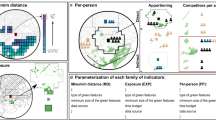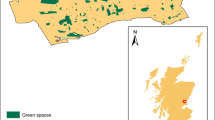Abstract
The spatial distribution and availability of accessible Urban Public Green Spaces (UPGS) represents an important measure of spatial inequality, and touches some of the major goals of urban sustainability, including an equitable improvement of ecosystems services and public health. The traditional tools for the assessment of UPGS availability frequently used in the planning practice are often inadequate to capture relevant features of UPGS availability and accessibility, neglecting the intricacies of urban space. To show this, we propose a comparison between UPGS availability evaluated through a conventional method of “planning standards” and that of a “high-fidelity” accessibility evaluation model. For the latter we employ the method of UPGS distance-cumulative-deficit (UPGS-DCD) index, which we have recently constructed. The comparative analysis was applied to the city of Cagliari (Italy) in order to verify the differences between the results of the two assessment methods. In light of these results, we suggest that UPGS planning, and urban planning and design in general, should employ more adequate assessment methods, grounded on more appropriate assumptions on the behaviours of city users and a more accurate representation of urban space. Following this, we suggest that the proposed UPGS-DCD index offers a viable tool for supporting urban planning, policy, and design.
Access this chapter
Tax calculation will be finalised at checkout
Purchases are for personal use only
Similar content being viewed by others
References
Banchiero F, Blečić I, Saiu V, Trunfio A (2020) Neighbourhood park vitality potential: from jane jacobs’s theory to evaluation model. Sustain 1215):5881
Blečić I, Saiu V, Trunfio GA (2020) Towards a High-Fidelity Assessment of Urban Green Spaces Walking Accessibility. In: Proceedings of the Computational Science and Its Applications—ICCSA 2020, Cagliari, Italy, 1–4 July; Gervasi O, Murgante B, Misra S, Garau C, Blečić I, Taniar D, Apduhan BO, Rocha AMAC, Tarantino E, Torre CM, Karaca Y (eds) (2020) Lecture Notes in Computer Science—LCNS, vol 12252, Springer International Publishing, Cham, Switzerland
Daniel P, Burns L (2018) How steep is that street? Mapping ‘real’ pedestrian catchments by adding elevation to street networks. Radical Statistics 121:26–48
Li L, Du Q, Ren F, Ma X (2019) Assessing Spatial Accessibility to Hierarchical Urban Parks by Multi-Types of Travel Distance in Shenzhen, China. Int J Environ Res Public Health 16:1038
Saiu V (2017) The three pitfalls of sustainable city: a conceptual framework for evaluating the theory-practice gap. Sustain 9(12):2311
Saiu V (2020) Evaluating outwards regeneration effects (OREs) in neighborhood-based projects: a reversal of perspective and the proposal for a new tool. Sustain 12:10559
Teimouri R, Yigitcanlar T (2018) An approach towards effective ecological planning: Quantitative analysis of urban green space characteristics. Global J Environ Sci Manage 4(2):195–206
UNDESA (2020) World Social Report 2020: Inequality in a Rapidly Changing World. https://www.un.org/development/desa/dspd/wp-content/uploads/sites/22/2020/02/World-Social-Report2020-FullReport.pdf. Last accessed 6 July 2020
Author information
Authors and Affiliations
Corresponding author
Editor information
Editors and Affiliations
Rights and permissions
Copyright information
© 2021 The Author(s), under exclusive license to Springer Nature Switzerland AG
About this paper
Cite this paper
Blečić, I., Saiu, V. (2021). Assessing Urban Green Spaces Availability: A Comparison Between Planning Standards and a High-Fidelity Accessibility Evaluation. In: La Rosa, D., Privitera, R. (eds) Innovation in Urban and Regional Planning. INPUT 2021. Lecture Notes in Civil Engineering, vol 146. Springer, Cham. https://doi.org/10.1007/978-3-030-68824-0_37
Download citation
DOI: https://doi.org/10.1007/978-3-030-68824-0_37
Published:
Publisher Name: Springer, Cham
Print ISBN: 978-3-030-68823-3
Online ISBN: 978-3-030-68824-0
eBook Packages: HistoryHistory (R0)




